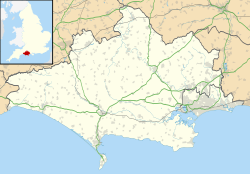| Buckhorn Weston | |
|---|---|
 Parish church of St John the Baptist | |
Location within Dorset | |
| Population | 356 [1] |
| OS grid reference | ST756246 |
| Unitary authority | |
| Ceremonial county | |
| Region | |
| Country | England |
| Sovereign state | United Kingdom |
| Post town | Gillingham |
| Postcode district | SP8 |
| Dialling code | 01963 |
| Police | Dorset |
| Fire | Dorset and Wiltshire |
| Ambulance | South Western |
| UK Parliament | |
Buckhorn Weston is a village and civil parish in the English county of Dorset, situated in the Blackmore Vale about 3 miles (5 kilometres) west of the town of Gillingham. It lies on the western edge of the former royal hunting ground of Gillingham Forest. The underlying geology is Oxford clay and Corallian limestone. [2] In the 2011 census the civil parish had a population of 356. [1]

